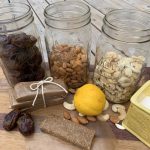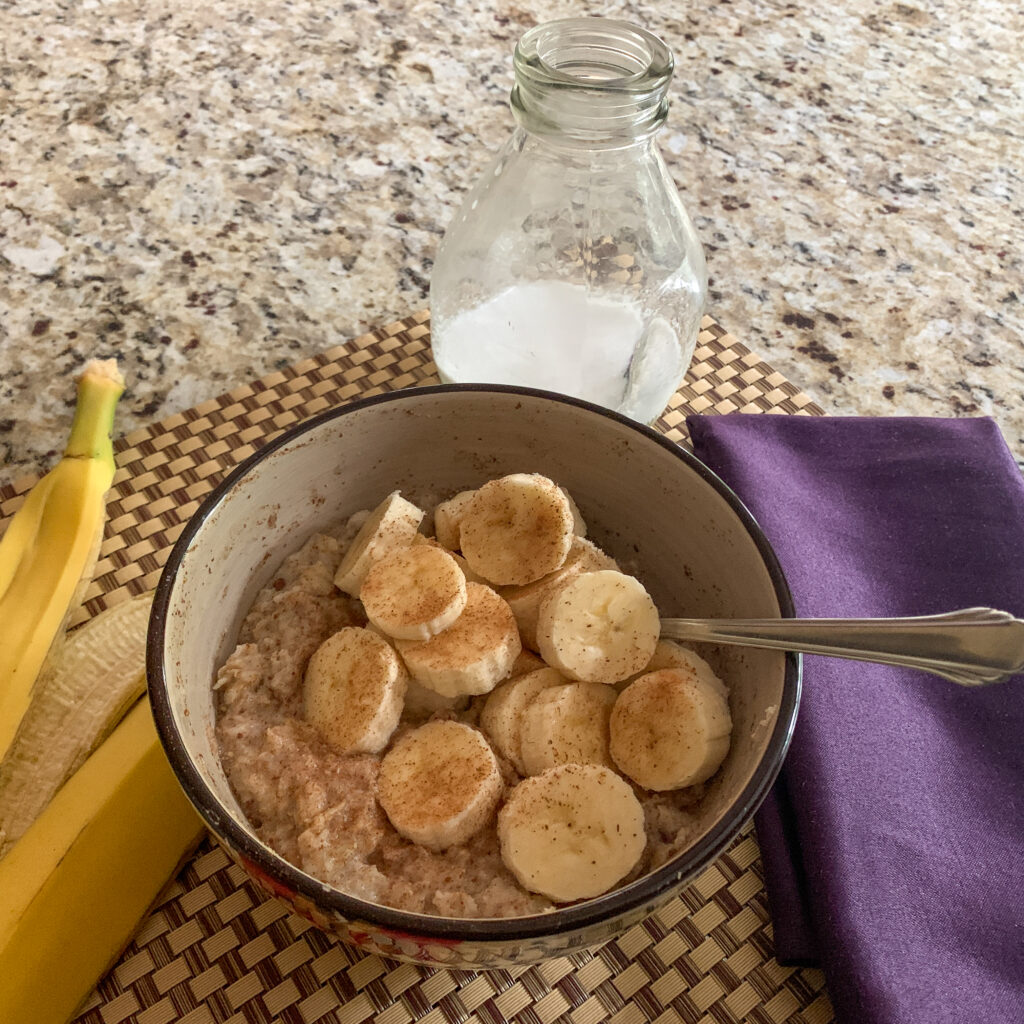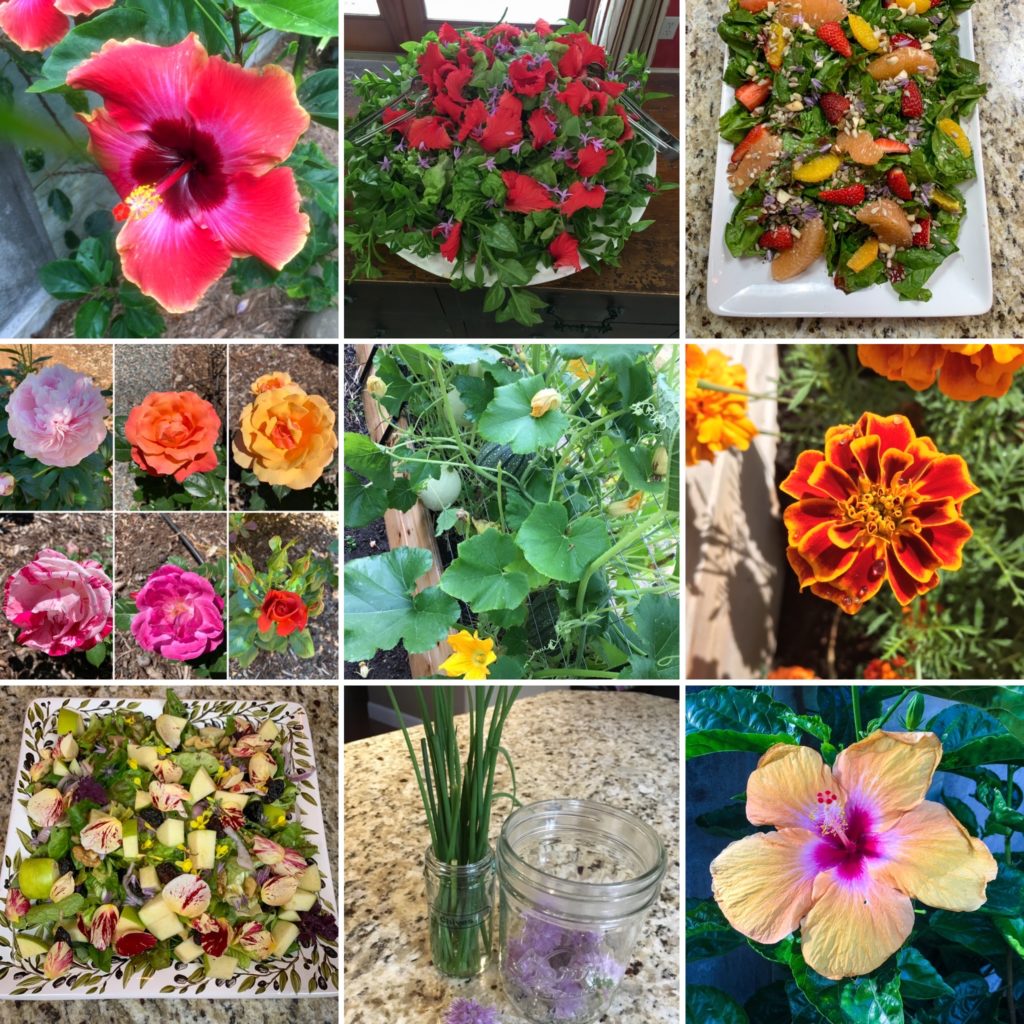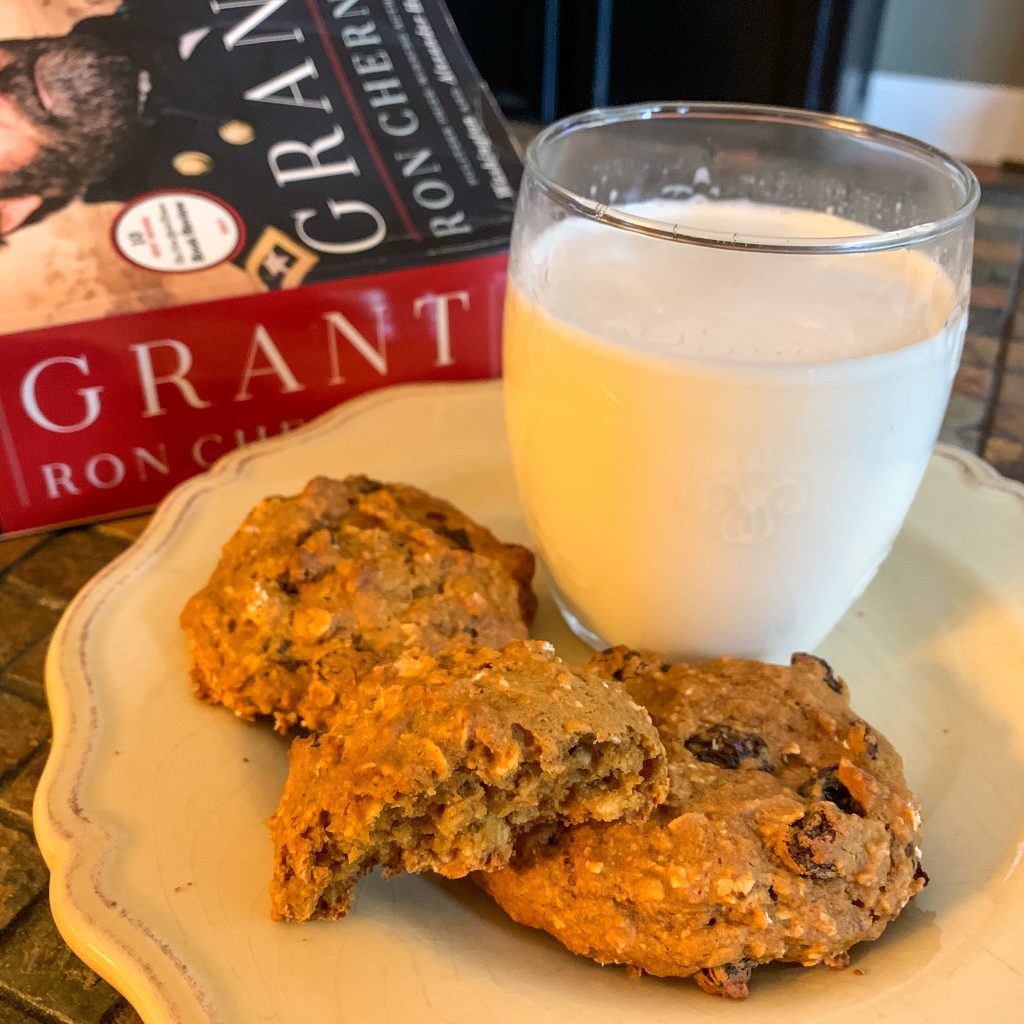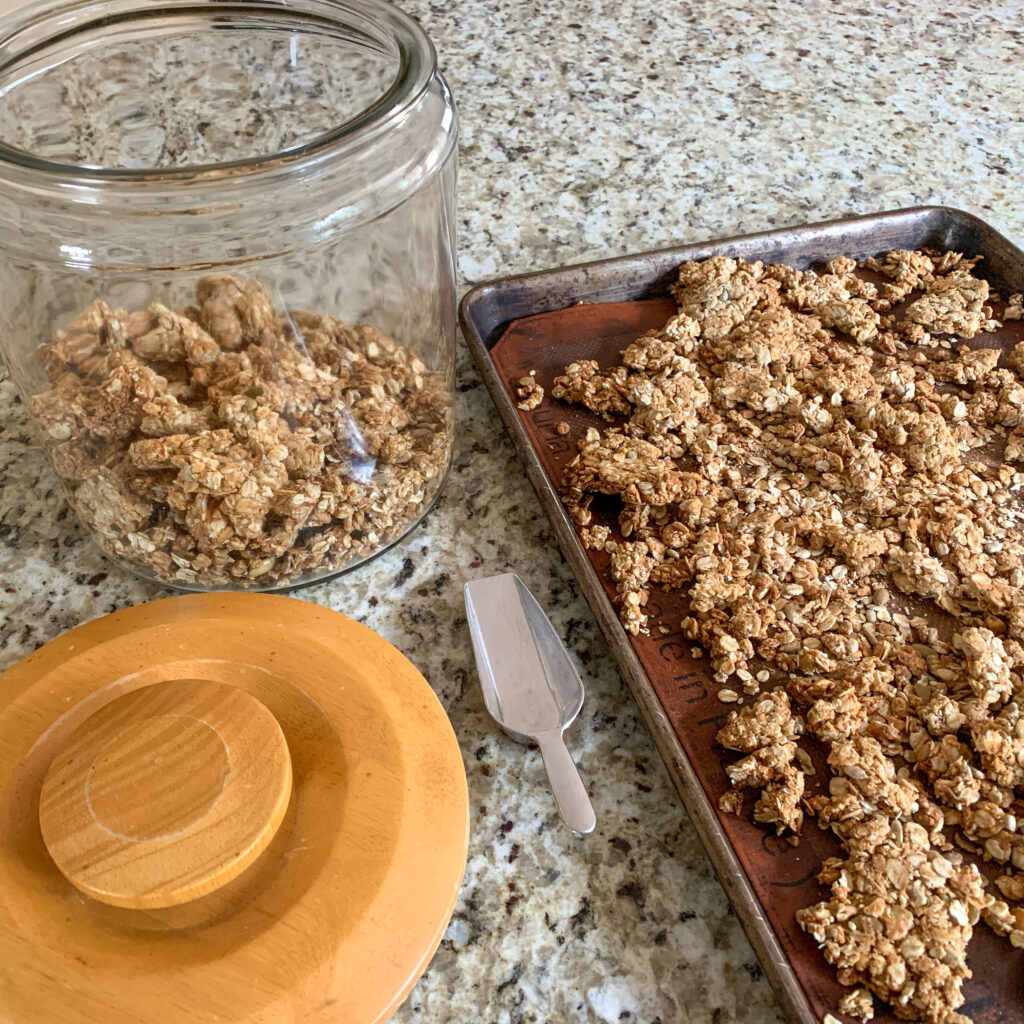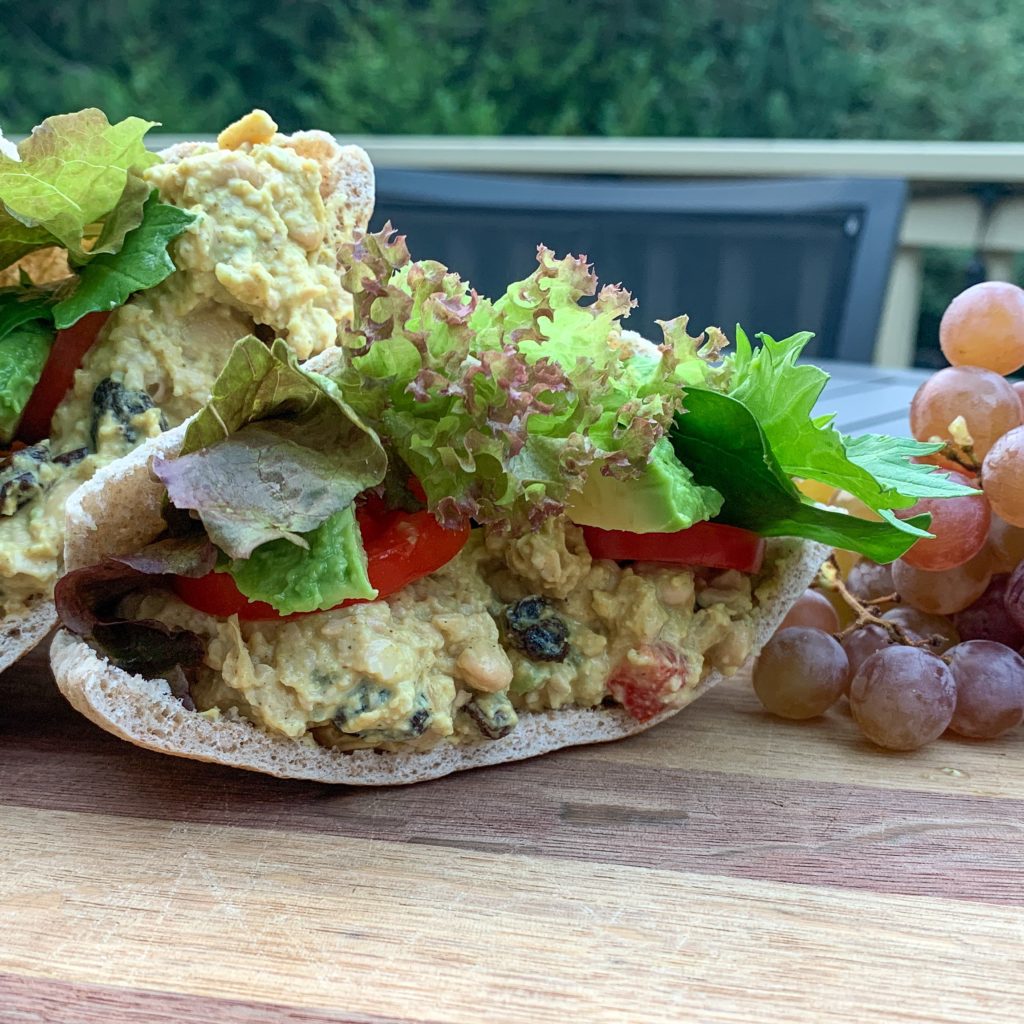Dating in Palm Springs & Lemon (Not Lära’s) Bars Recipe

We recently took a holiday to Palm Desert, California for ten days. It was the first time I’d ever been to that area and I absolutely LOVED IT! The weather was perfect, mid-80s, not humid, and there is a lot of do and see there.

Shields Date Gardens, Indio, CA
Something I didn’t realize until we were getting ready to head down was that the Coachella Valley, just east of Palm Springs, is the date capital of the United States! 95% of America’s dates (about 30 million pounds!) are grown here. I’d ordered dates from the Shields Date Garden before and knew they were located there, but I had no idea just how special this region was. We added trips to Shields Date and Oasis Date Gardens to our itinerary because I really wanted to learn about dates. Wow, did I ever learn about dates!

Oasis Date Gardens, Indio, CA
The story about how the Coachella Valley got into growing dates is fascinating! The US Department of Agriculture brought dates to the region in the 1900s, looking to bring exotic food agriculture to the US (this program also brought avocados, mangos, oranges, quinoa, kale, and the like, as well). By the 1920s, date palms were thriving, and combined with inexpensive land, the widespread availability of the automobile, and an American love affair with all things Middle Eastern, people flocked to the desert in search of this ancient fruit.

Palm grove, Shield Date Gardens, Indio, CA. Notice the ladders the workers climb to pollinate and harvest?
Date palms are very particular and while date farming had been unsuccessful in other parts of California, the climate and water availability of the valley are perfectly suited to support date farming. These trees require land with abundant water but a hot, dry climate. Huge aquifers beneath the valley floor were perfect for supporting date palms in this otherwise arid region, providing a necessary 10 acre-feet of water per year, the equivalent of 120-inches of rain. As noted by the Shields Date Garden, “A date palm must have it’s feet in the water and it’s head in the fires of heaven.”

Date palm off-shoot
But cultivating dates is tricky, you can’t just put a date pit in soil and get the same variety date that you planted. Instead, you have to transplant shoots from parent trees. It takes 15 years for a date palm to mature and produce date crops, but during this time, the trees produce off-shoots, or suckers, around its base that are carefully removed and planted to propagate that variety. It takes approximately five years before a date palm sucker has developed their own root system and can be removed and transplanted, into groves of primarily female trees.
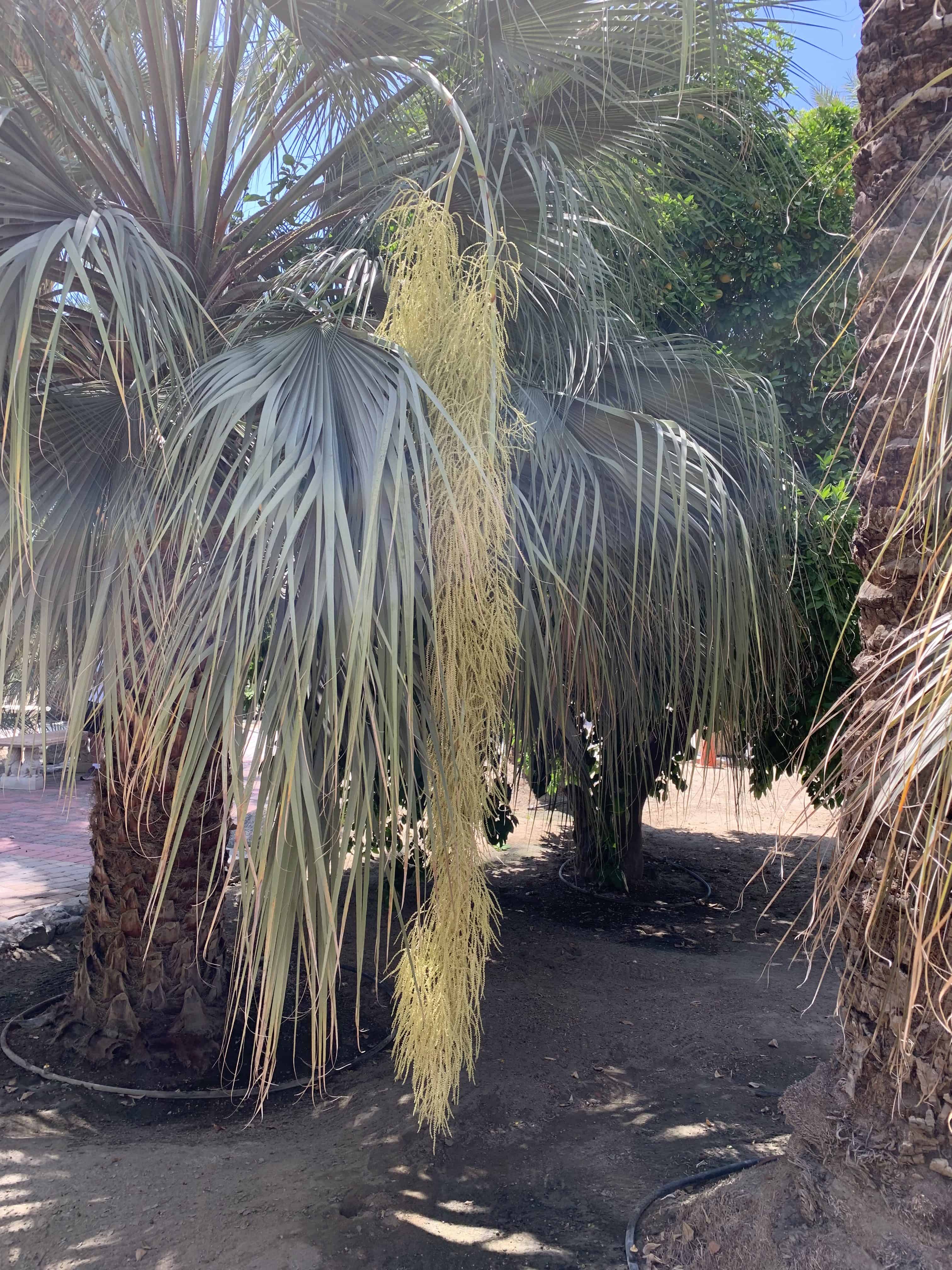
Date palm flower, Shields Date Garden, Indio, CA.
And here’s where growing dates gets even more labor intensive! E. Floyd Shields put his date farm on the map with his film, The Romance and Sex Life of the Date, describing this process. Date palms are extremely poor pollinators and require human intervention in order to produce dates. When the male trees flower, the blooms are cut from the tree and shaken to extract pollen, approximately 1/2 a cup per flower stalk. Each male tree produces enough pollen for 48 female trees, so each acre is planted accordingly. Workers then climb up the female trees with the collected pollen to hand-pollinate the female flowers! After the female tree develops young dates, workers return to cull branches, allowing the trees to produce larger, better dates. While they are developing, the date bunches are covered with waterproof bags to prevent damage from any rainfall or hungry birds. Dates do not ripen in a bunch all at once, like other fruit, and thus have to be picked individually by hand by workers who climb each tree every day during the harvest, about 6-7 months after pollination. Depending upon the variety, a female tree produces between 150-300 pounds of dates per year upon full maturity and continues producing for 40-50 years. This labor-intensive process explains why dates are one of the most expensive crops to produce.

Developing dates in waterproof covers for protection from birds, insects, and rain. Oasis Date Gardens, Indio, CA.
Fascinating, isn’t it? Here’s the film, The Romance and Sex Life of the Date, that runs at Shields Date Garden, explaining all about their process. It’s really interesting!
The Romance & Sex Life of the Date
A short film based on the 1951 slideshow created by E. Floyd Shields
Date Varieties

Bulk date shopping at Oasis Date Gardens, Indio, CA.
There are more than 3,000 varieties of dates, but only a dozen or so varieties are grown in the US. They are categorized as semi-soft, soft, and dry/bread. Here are some of the most common ones you find in the Coachella Valley:
Semi-Soft Dates
- Deglet Noor: “Date of Light.” Most common US variety (95% of US production), introduced in 1900 from Algeria. It has firm flesh, chewy, firmer than Medjool, making them easier to chop, and a color range from light red to amber. Good for eating or baking.
- Medjool: Introduced to the Coachella Valley in 1927 from French Morocco. Original Moroccan trees have since died of a disease, hence all of the world’s Medjool dates now descend from offshoots taken from Coachella Valley stock. Often called the “Cadillac” of dates, they are large (4-5 times bigger than other dates) but has a small pit, sweet, moist, creamy, meaty, and firm-textured. High in potassium, thus a terrific food for athletes.
- Zahidi dates: Introduced in 1902 from Northern Iraq/Iran. Often called “Nobility.” Less sweet than others, has a large seed, and a crunchy fibrous flesh. Great for baking and stores well. Used for making date crystals and date sugar. This was my favorite variety!
- Abbada: Almost black at maturity, semi-soft flesh with a very rich flavor.
- Blond and Brunette: Hybrids created by E. Floyd Shields in 1927. Medium sweet, creamy, and only available at Shields Date Garden.
- Honey: Hybrid from the Coachella Valley. Has a creamy, melt-in-your-mouth sweetness, like honey.
Soft Dates
- Barhi: Originally from Iraq. Softest of all of the dates, they are medium-sized, thin-skinned fruit with soft, tender flesh and a syrupy, butterscotch flavor. Named for the hot Arabic winds called “Barh.”
- Halawi/Halawy: Originally from Iraq. Thick, golden flesh, tastes like caramel, and extremely sweet, sweeter than Deglet Noor. Described as having vanilla or maple notes.
- Khadrawy: Also from Iraq. Similar to the Halawi, they have a caramel/pudding-like texture and sweet flavor. They are the second most common date grown in the US and the first to ripen.
Dry/Bread Dates
- Thoory dates: This is a very dry date with firm skin, good for hiking or traveling as they are not sticky.
Storage

You can order bulk boxes of dates to be shipped in cardboard containers from Shields Date Garden. They may be lined with a plastic bag (which you can put in plastic bag recycling), but at least it won’t be in a non-recyclable plastic clam shell container, like the smaller packages.
Dates store very well! Seal tightly in a container:
Refrigerated (32-40˚F): 1 year
Frozen, <32˚F): 5 years
Nutritional Information
An average date has about 21 calories
Serving size: 5-6 dates (40g) = 120 calories

Date development by days, Oasis Date Gardens, Indio, CA.
- Fat-free
- Cholesterol-free
- High in antioxidants
- Contain minerals: calcium, magnesium, manganese, zinc, copper, iron, selenium, and potassium
- Contain vitamins: thiamine, riboflavin, niacin, B6, and panthothenic acid
- Naturally sweet
- High in fiber
- Approximately 2% protein
Using Dates
If you’ve stored dates in the refrigerator or freezer for a long time, you can simply refresh them by soaking in 80˚F warm water for 20-30 minutes. Drain and pat dry before using.
Date Paste
This is a great way to use dates to sweeten recipes. Remove the pits and soak your dates as described above, but reserve the soaking liquid you drain off and don’t dry the dates. Add the drained dates to your food processor with a little of the soaking water and blend until smooth. Add more water if needed. Store in a container in your refrigerator for up to 2 weeks.
Add to oatmeal, dressings, etc. You can substitute it 1:1 for maple syrup in recipes.
Date Crystals and Date Sugar

We loved the plastic-free packaging of Shields Date Crystals and Date Sugar!
Shields Date Garden is well-known for their Date Crystals and Date Sugar, two items they developed and patented.
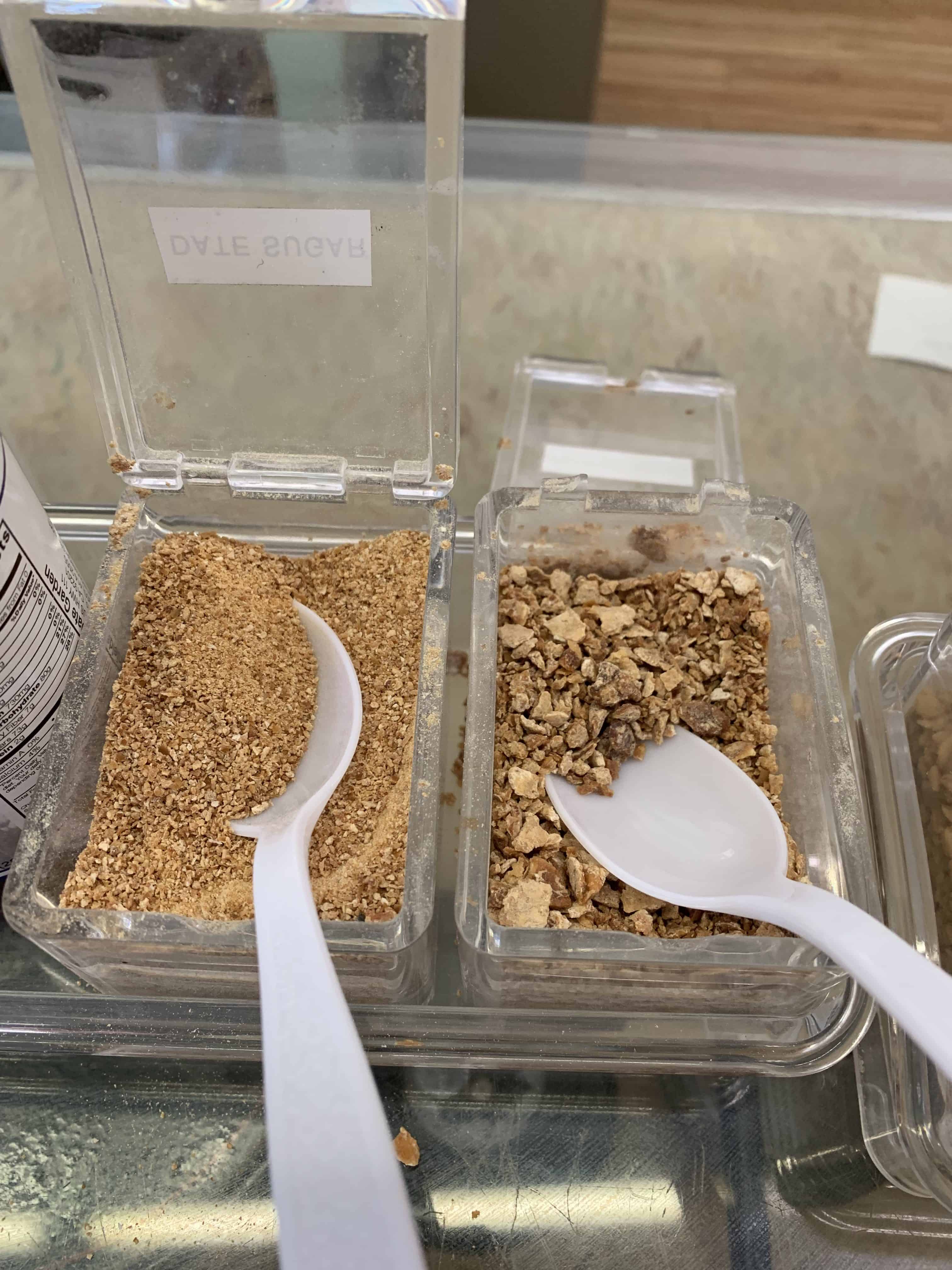
Date Sugar (left) and Date Crystals (right), Shields Date Garden, Indio, CA.
Date crystals are dried, chopped dates. Shields is famous for its Date Shakes made with their date crystals (note, we didn’t get to try one of the famous shakes because they do not have a dairy-free option for their ice cream, unfortunately). You can use date crystals 1:1 as a substitute for chopped dates, but you need to add 1/3 cup of water to each cup of date crystals you use.
I bought a can of Date Sugar, just finely ground crystals, during our trip and am using it 1:1 for sugar in recipes, like I do with Coconut Sugar, and have had great results so far. I like the fact that date sugar, like coconut sugar, contains fiber, unlike refined white sugar. And, it has not been filtered through bone char, thus vegan!
Using Whole Dates
Whole dates make a great snack! I love to make Snickers Bites with them, which I showcased at the Duvall Chamber of Commerce meeting in 2018 (click here to find the post with the recipe).
I also like to make energy bars (or balls) with them, very similar to Lärabar, made with simple ingredients. You can make them ahead and store in the refrigerator or freezer. High in potassium and protein, they make great camping, hiking, travel snacks, but you need to keep them in a container or in parchment paper so they don’t get your pack or pockets all sticky! Recipe for my Lemon (Not Lära’s) Bars is below.
A Culinary Adventure!
We loved learning all about dates during our trip. Alan and I enjoy taking time to learn about the areas we travel to, including the agriculture and cuisine of that region. Our tours of the Coachella Valley date gardens made us appreciate just how resource-intensive dates are—we really had no idea. In fact, because they are such a water-guzzling crop, we will be mindful of how many we use, keeping them special, as they really are! Anyway, they are expensive, so we were careful with them before! At least now we know WHY dates are so expensive and so special.
Lemon (Not Lära's) Bars
Ingredients
- 2 cups raw cashews whole or pieces
- 2 cups raw almonds skins on is just fine
- 1 cup dates, your choice pitted
- zest of two lemons
- juice of two lemons
- 2 pinches salt optional
Instructions
- Put all ingredients into a food processor fitted with the S-blade and blend until comes together into a consistency that will hold together, about 3-5 minutes. May have to stop and scrape down the sides occasionally.
- For bars, scrape into a 9x13 pan lined with waxed or parchment paper and pat into a smooth, even layer. Pull the whole thing out on the paper and cut into bars. Wrap individually in parchment or wax paper to store.
- For balls, roll out portions between your hands. Store in a sealed container.
Storage
- Room temperature: 3 days
- Refrigerator: 3 weeks
- Freezer: 3 months
Nutrition
Do you like this post? Please share....
[mashshare]
If you liked this post, you might like one of these:
Categories:
Tags:
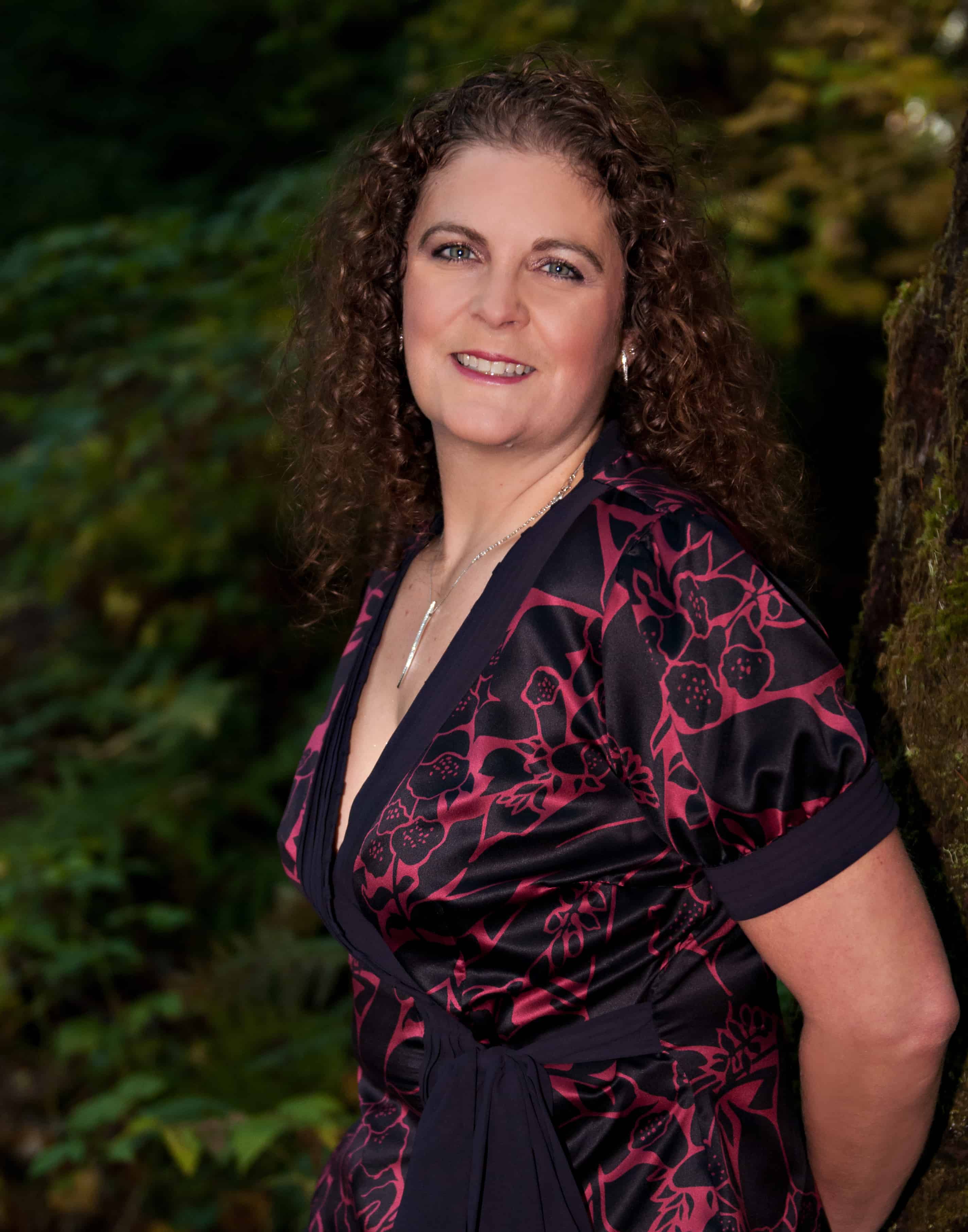
[Trī-māz-ing]
Cindy wants you to be Trimazing—three times better than amazing! After improving her health and fitness through plant-based nutrition, losing 60 pounds and becoming an adult-onset athlete, she retired from her 20-year firefighting career to help people just like you. She works with people and organizations so they can reach their health and wellness goals.
Cindy Thompson is a national board-certified Health and Wellness Coach, Lifestyle Medicine Coach, Master Vegan Lifestyle Coach and Educator, Fitness Nutrition Specialist, Behavior Change Specialist, and Fit2Thrive Firefighter Peer Fitness Trainer. She is a Food for Life Instructor with the Physicians Committee for Responsible Medicine, Rouxbe Plant-Based Professional, and Harvard Medical School Culinary Coach, teaching people how to prepare delicious, satisfying, and health-promoting meals.
She provides health and lifestyle coaching at Trimazing! Health & Lifestyle Coaching. Cindy can be reached at info@trimazing.com.
Subscribe to the Trimazing Blog
Receive occasional blog posts in your email inbox.
Subscribe to the Trimazing Blog
Receive occasional blog posts in your email inbox.

